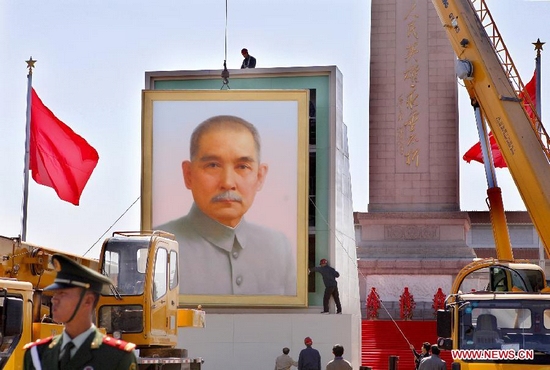Sun Yat-sen-led revolution commemorated
 0 Comment(s)
0 Comment(s) Print
Print E-mail
Xinhua, October 3, 2011
E-mail
Xinhua, October 3, 2011
Facing the portrait of Mao Zedong hung on the Gate of Heavenly Peace, a gate to the Forbidden City, a portrait of Dr. Sun Yat-sen stood on the tourist-packed Tian'anmen Square on Sunday, eight days ahead of the centenary of the 1911 Revolution, which was led by Sun and toppled China's last dynasty.
Tourists crowded in front of Sun's portrait and took pictures on the second day of the National Day holiday. Sun is revered as the forerunner of democratic revolution in China.
The 1911 Revolution, which began on October 10, 1911 with an armed uprising, ended 2,000 years of imperial rule by toppling the Qing Dynasty (1644-1912) and resulted in a republican government, the first in Asia.
As 1911 was called Xinhai in the traditional Chinese way of numbering years, the revolution is named Xinhai Revolution.
In the city of Nanjing in Jiangsu Province, Sun's tomb and presidential office received tens of thousands of visitors at the beginning of the week-long holiday.
Over 50,000 tourists visited the tomb on Saturday, said an official with the tomb administration. The administration expects to see a record-setting 500,000 visitors during this year's National Day holiday, he added.
The newly-repaired presidential office, which has been transformed into a museum, staged an exhibition on Sun Yat-sen and the provisional republican government during the holiday.
The office attracted many more tourists than at other times, according to the museum administration.
A tourist named Wang Huawen said he chose to visit the presidential office because it was the site of many events that influenced Chinese history.
In the city of Wuhan in central China's Hubei Province, a photography show dedicated to the 1911 Revolution started on Saturday in front of the office building of the Hubei Military Government, which was established one day after the Wuchang Uprising that ushered in the revolution.
"The pictures were very precious to me. They vividly showed me how hard the revolutionaries fought to defend the fruits of the Wuchang Uprising," said Wang Mengshi, a college student.
Tourism was not the only sector boosted by the 100th anniversary of the 1911 Revolution. A star-studded blockbuster titled "Xinhai Revolution" was also screened to commemorate the event.
The film is expected to attract a great number of filmgoers during the National Day Holiday, film industry insiders said. Media reported that the film had pulled in 18 million yuan (2.9 million U.S. dollars) at the box office in three days after its debut on September 23.
The film has been popular, especially among young people, said a staff member with New Century Cinema, one of Beijing's biggest cinemas.







Go to Forum >>0 Comment(s)